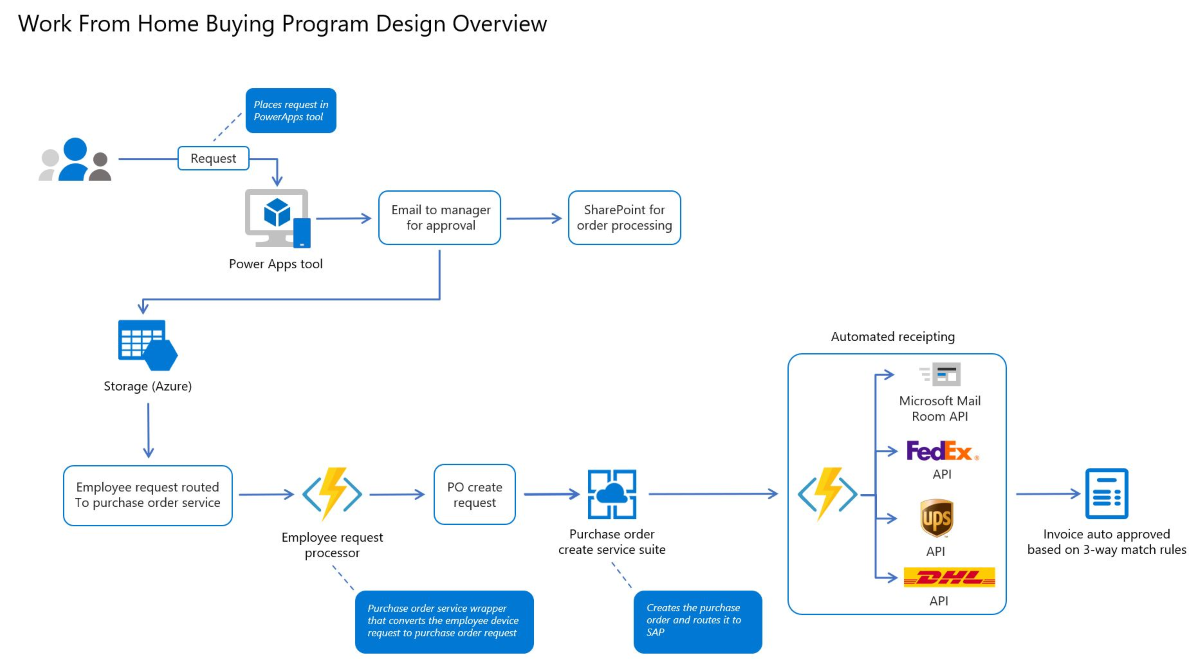This content has been archived, and while it was correct at time of publication, it may no longer be accurate or reflect the current situation at Microsoft.
Thanks to a procurement automation effort being underway at Microsoft when the COVID-19 hit, the company was able to smoothly supply its employees with the equipment they needed to suddenly outfit their home offices.
Microsoft responded to a companywide work-from-home order to quickly build out a work from home buying program that could provide device accessories such as monitors, headsets, docking stations and mice to its 168,000 employees. The effort was led by Microsoft’s Procurement team in Corporate Finance.

Microsoft Power Apps was the obvious tool to quickly create an automated interface for employees to request needed supplies, says Her Kait Seet, a senior finance manager on the Procurement Reporting team in Corporate Finance.
“When Microsoft introduced Power Apps, it meant any business user could go in and build a tool,” Seet says. “That’s exactly what we did.”
Employees used the tool to order accessories they needed, and the Procurement team used it to ship them to their homes.
As it became apparent that COVID-19 would be a prolonged battle, the work from home buying program saw greater evangelization from company leadership. That led to the number of order requests shooting up from 50 per day to 600 to 700 per day at the peak.
While the Power App facilitated the front-end request process, the purchase order creation, approval, receipt of goods and invoice approval process coming in from the app was entirely manual.
“The team did not anticipate the huge spike in volume,” says Dan Detjen, senior program manager for the Procurement team. “We weren’t ready. We needed help from other team members, and our contractors were working extra hours during the night and weekends.”
The initiative ask came from leadership saying we need to support employees. Time was of the essence.
– Timish Garg, operations manager, Microsoft Procurement
As requests piled up, employees were waiting two to three weeks to receive their items, compared to a couple of days’ wait time before the surge in demand.
But Microsoft leadership had made it an imperative to support its workforce at home, says Timish Garg, an operations manager for Microsoft Procurement. “The initiative ask came from leadership saying we need to support employees,” Garg says. “Time was of the essence.”
[Learn how Microsoft automated revenue processing with Power Automate. Find out how Microsoft is enabling remote work with cloud-first file management and collaboration.]
Highly manual to no-touch
An almost entirely manual entry process with low volumes needed to move to full no-touch procurement automation, and scale to handle much larger quantities of requests.
The team needed a solution that would receive the employee request, match it up with available item inventory, and automatically generate and approve a purchase order. Once the item was shipped to the employee’s address, the receipt confirmation needed to be automated as well.
So, the Purchase Order, Receipting, and Power Apps teams joined forces to solve the problem from end-to-end.
They identified plenty of challenges during the design stage.
For one, the pandemic had triggered wide fluctuations in hardware availability across global markets.
“The system is very dependent on the supplier,” says Vijay Bandi, a senior software engineer for Microsoft Procurement. “So, it was very challenging, but critical, to make the system as configurable and flexible as possible.”
Using in-house tools such as Microsoft’s rule engine framework helped the team create configurable rules that didn’t require any code changes or deployments. Leveraging the microservices architecture of MyOrder (the company’s internal ordering application) and Microsoft’s Enterprise Integration Service also helped integrate these signals to communicate with the Power App at scale.
Another challenge in the procurement automation was maintaining accountability at the end of the process. When an employee receives a device in the office, it’s tracked through campus mailrooms. Shipping to someone’s home is another story.
“Engineering and business teams had to think out of the box—and quickly—to save users time while confirming their goods were received,” says Ratna Rekha Koukuntla, principal software engineering manager for Microsoft Procurement.
They investigated various delivery carriers to determine which could best integrate via existing APIs, ultimately identifying FedEx and UPS as the top carriers who could integrate the most effectively and swiftly to make sure goods were tracked and accounted for to their final destinations.

Solutions for the new hybrid world
Innovation is born out of crisis. It’s a big showcase of how agile and adaptable Procurement and Microsoft Digital can be in meeting business needs and delivering the outcomes needed with a sense of urgency and clear focus.
– Timish Garg, operations manager, Microsoft Procurement
Now active in 20 countries and regions globally, the automated procurement system is handling 70 percent of all device requests at the company. The processing time has been reduced from nine to two days. And the touchless system is projected to save $200,000 to $300,000 in annual operational costs over the next few months.
For the people involved, the new procurement automation has enabled the Procurement team to go back to working normal hours and at normal staffing levels. As for employees working at home, they’re getting the hardware they need in a timely fashion.
“Innovation is born out of crisis,” Garg says. “It’s a big showcase of how agile and adaptable Procurement and Microsoft Digital can be in meeting business needs and delivering the outcomes needed with a sense of urgency and clear focus.”
When the pandemic crisis eases, the automated ordering system will be well-positioned to support the future of work in an altered world.
Throughout the process of such rapid modernization, the Procurement team gained valuable experiences and learnings, such as the importance of rigorous end-to-end monitoring and testing, to make sure the system is functioning properly.
“Ultimately, we now have the tools and systems which can support and scale once we’re back to normal,” Garg says. “As more employees have the choice to work from home in the future, we can leverage it.”
The Procurement team is now focusing on taking these learnings to improve the experience of various employee hardware purchases.
Koukuntla adds that the procurement automation program also offers a strong example of Microsoft’s customer obsession—with its own employees as its first and best customer. “We were customer-obsessed to help our employees in this situation,” Koukuntla says. “At the same time, we’re creating automated and touchless experiences to increase user productivity.”
Learn how Microsoft automated revenue processing with Power Automate.
Find out how Microsoft is enabling remote work with cloud-first file management and collaboration.





